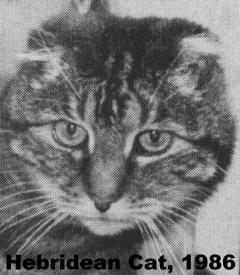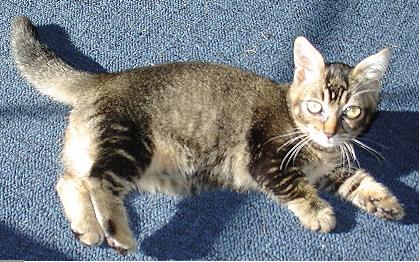
A Hebridean Fold - a spontaneous mutation

Tellie - a random short-legged mutation
(Aimee Johnson, October 2003).
WHO "OWNS" A MUTATION?
WHAT IS A STRUCTURAL MUTATION?
A “structural mutation” is one that affects the appearance of the skeleton (bones or cartilage) and produces something different from the average domestic cat i.e. folded ears, curled ears, short legs, short or absent tail, etc. It does not cover brachycephaly (short muzzle), polydactyly or bobtail as these are already widespread in the cat population (brachycephaly may result from a recessive mutation that 19th century breeders selected for). It does not cover colour or fur type.
This seems to follow a concern many years ago that there would be a flood of “munchkinised versions” of established breeds. There is also the very valid concern that multiple structural mutations can interact in a way that seriously impacts health e.g. the thickened cartilage of the Scottish Fold mutation might adversely affect a short-legged cat. While responsible breeders have good health, a clear target and consistent conformation in mind, there are less ethical breeders that mix and match mutations, give the kittens a portmanteau name, and sell them as designer cats. Because they are breeding for bucks, they aren’t breeding their mix-and-match cats to meet a standard.
WHO OWNS A MUTATION?
 A Hebridean Fold - a spontaneous mutation |
 Tellie - a random short-legged mutation (Aimee Johnson, October 2003). |
So who owns a mutation and what do they own? Do they own the phenotype (the look) or the genotype (the gene mutation causing that look)? In the 1970s, the CFA (a US registry) would not recognise the Ragdoll because of its physical similarity to the Birman.
Does the recognition of the PixieBob prevent other polydactyl breeds from being recognised (such as the Clippercat)? Does the recognition of the contemporary Siamese prevent recognition of other breeds with long, narrow heads? There needs to be a clear definition of “mutation” - physical trait vs genetic mutation. Unrelated random mutations can create identical physical traits.
Breed X "owns" a mutation if, in order to get that mutation into Breed Y, you have to use Breed X in your breeding programme. Mutations that are already widespread in the cat population can’t be owned. Even this isn’t clear-cut because an identical trait coould turn up in cats that have had no contact with Breed X. The American Curl supposedly “owns” the curled ear mutation because the only way to get another curl-eared breed is to use American Curls in the breeding programme. A curled ear cat (Matilda) turned up, completely at random, in Australia where there were no American Curl cats. Had Matilda given rise to a new curl-eared breed, completely independent of the American Curl, could the American Curl still “own” the curled ears mutation? Would the genetically unrelated Australian Curl be recognised by TICA?
Any mutation that is already a breed-specific trait can turn up again somewhere through spontaneous mutation. Hairlessness has turned up multiple times around the world. Short-legged cats have also turned up multiple times around the world. Cats with looped-over tails have occurred in random-bred cats in Europe and North America (and probably elsewhere). Ergo Sphynx cannot "own" hairlessness and Munchkin cannot "own" short legs though they may be an obstacle to any further short-legged breeds being recognised.
Pet quality Breed X may stray and/or produce mongrel kittens. Breed X’s mutation can escape into the random-bred population. Random-bred cats of unknown ancestry could be used for a new breed without having to ask Breed X’s section for permission to use the mutation. To combat this, without paddling in the muddy waters of who “owns” a mutation, most registries simply have regulations that mean they won’t recognise lookalike or duplicate breeds. Their criteria for recognising a new breed requires uniqueness.
CONSIDER THIS SCENARIO
Note: In reality, eye colour and fur colour are not structural mutations and there is no dominant black gene in the domestic cat; these just make a convenient scenario that doesn’t resemble an existing breed!
Playing devil's advocate, imagine the following fictional scenario. Frau X discovers a family of short-legged, smooth-coated, blue-eyed jet black cats. She breeds them to a farm cat and discovers: the short-legs gene is recessive (so not a Munchkin), the black colour is dominant (even over white) and the smooth coat and sapphire blue eyes are linked to the black colour (so not Ojos Azules mutation). Who owns what? There's no Munchkin blood and it's a different gene producing a similar phenotype. There's no Ojos Azules blood since that breed never made it to Frau X's area. It's a completely novel breed due to the black masking gene, but 2 other defining physical traits of the breed are "owned" by breeds that haven't contributed to its existence, and one of those traits is inextricably linked to the colour.
Is this a new breed as the genetics are different? That all depends on whether the registry defines "mutation" as genotype or phenotype. Frau X's cat looks like a Munchkin. It also looks like an Ojos Azules. If the Munchkin "owns" the short legs trait and the Ojos "owns" sapphire blue eyes (in non-whited, non-colourpoint cats) that would be an obstacle.
PRIOR ART AND PRECEDENCE
Some breeders have attempted to “own” a trait or combination of traits (not necessarily structural) by trademarking their breed. While it’s possible to trademark a novel combination of traits, it’s not possible to effectively trademark a single trait. Imagine a scenario where breeders of the older-style Siamese trademarked their seal-point, blue-point, choc-point and lilac-point cats. All of these colours are found in the Maew Boran (native Thai breed and predecessor to westere Siamese cats) and nature does not recognise trademarks. Would it be legitimate to block recognition of the ancient Maew Boran breed because some of its colours are “owned” by a breed developed (i.e. refined) in the west in the 1800s? Besides, who do you sue when feral and random-bred cats continue to infringe your trademark?
To my mind, the only mutations that can be “owned” are those created by genetic modification in a laboratory, such as fluorescent green cats. Any other mutation that has occurred in random-bred cats can occur more than once, effectively undermining the concept of ownership of a mutation.
CONCLUSION
A rule preventing unnecessary lookalike breeds and incautious breeding of structural mutations is sensible. A rule that allows Breed X breeders to prevent their breed being used in poorly thought out experimental breeding is also sensible. But a rule that suggests a breed “owns” a mutation needs to be carefully worded to define exactly what is owned, and how to deal with visually similar unrelated mutations. In a global cat fancy, such a rule must also be careful not discriminate in against not-yet-recognised native breeds that have prior claim on a mutation.